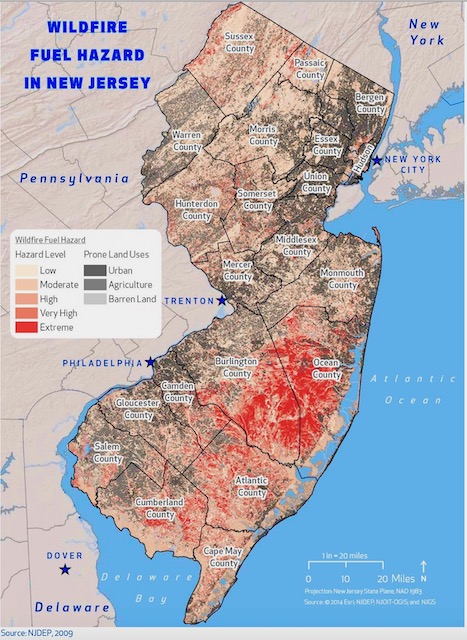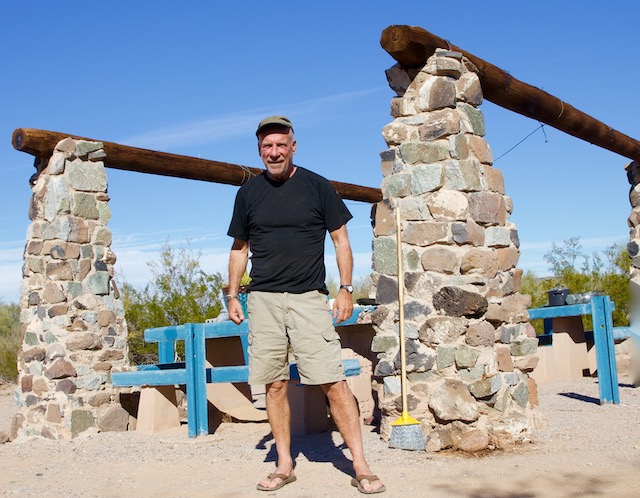In order to be eligible for hundreds of millions of dollars in federal disaster assistance funding from FEMA – including from a wildfire disaster – NJ is required to adopt a “Hazard Mitigation Plan” that outlines the risks and provides a planning framework for managing and reducing those risk.
In order to hold the Murphy administration accountable to its own DEP Commissioner’s legislative testimony, climate science, and Hazard Mitigation Plan, I submitted a joint petition for rulemaking to pressure the DEP, Pinelands Commission and Highlands Council to reduce wildfire risk and impacts by limiting new development and requiring fire prevention retrofits of existing development in extremely hazardous locations that are prone to wildfire.
DEP must publish a Public Notice of the filing of the petition and publish a formal response.
I’m not optimistic about the chances of these recommendations being adopted, but it is a first step. It sure beats cheerleading, which is about all NJ environmental groups seem to be doing these days.
Dear DEP Commissioner LaTourette; Pinelands Commission; and Highlands Council:
This letter petition is filed via email pursuant to N.J.S.A. 52:14B-4, which provides that:
“(f) An interested person may petition an agency to adopt a new rule, or amend or repeal any existing rule. Each agency shall prescribe by rule the form for the petition and the procedure for the submission, consideration and disposition of the petition. The petition shall state clearly and concisely:
(1) The substance or nature of the rule-making which is requested;
(2) The reasons for the request and the petitioner’s interest in the request;
(3) References to the authority of the agency to take the requested action.”
Accordingly, I hereby jointly petition the Department, the Pinelands Commission, and the Highlands Council for rulemaking as follows.
(1) The substance or nature of the rule-making which is requested
On February 10, 2022, DEP Commissioner LaTourette testified before the Senate Environment Committee to the effect, among other things, that he was “shocked” by the number of wildfires in NJ last year (apparently over 900) and that, according to the best available DEP science, wildfire risks and impacts were projected to increase due to climate change.
According to the most recent NJ Hazard Mitigation Plan (2019)
https://nj.gov/njoem/mitigation/pdf/2019/mit2019_section5-12_Wildfire.pdf
Section 5.12.1:
“New Jersey’s high population density has created land use pressures in which more people are moving from urban areas to build homes in rural wildland areas. With more people living in the State’s wildlands, the number of fires started could increase. A potentially explosive combination is created when hazardous wildland fuels interface home development, and an increased risk of human-caused ignition come together under extreme fire weather conditions.”
5.12.2.1 NEW JERSEY PINELANDS AND PINE BARRENS
“The New Jersey Pinelands is a fire-adapted forest ecosystem that depends on wildfire for reproduction and the control of fuel buildup. This forest community is one of the most hazardous wildland fuel types in the nation. Pinelands fires burn extremely hot and spread rapidly. New Jersey has a high population density and more people are moving from urban areas to build homes in rural wildland areas. With more people living in and enjoying the State’s wildlands for various forms of recreation, the number of potential fire starts and the seriousness of their consequences increases. A potentially explosive combination is created when hazardous wildland fuels, home development, and an increased risk of human-caused ignition come together under extreme fire weather conditions.
5.12.2 LOCATION
“The ecosystems that are most susceptible to the hazard are pitch pine, scrub oak, and oak forests. These are the vegetative fuels that are the most flammable.
In New Jersey’s north, northern hardwood, white pine, eastern hemlock, mixed oak, and a variety of other species including isolated stands of red spruce are part of the forest composition. The oak/hickory-type group is, and has been, the most common-type forest in New Jersey. This group makes up nearly half of New Jersey’s forested area. This forest contains many mast-producing species that provide important forage for wildlife.”
The Hazard Mitigation Plan classifies and maps wildfire risks, based upon DEP LU/LC data as “extreme”, “very high” “high” moderate” and “low”:
“NJFFS, a division of NJDEP, has developed Wildfire Fuel Hazard data for the State based upon NJDEP’s 2002 Land Use/Land Cover (LU/LC) datasets and NJDEP’s 2002 10-meter Digital Elevation Grid datasets. NJFFS took the NJDEP Modified Anderson Land Use/Land Cover Classification System 2002 and assigned Wildfire Fuel Hazard Rankings to it.” (5.12.10)
(see Map as Figure 5.12-4 Wildfire Fuel Hazard in New Jersey)
The Hazard Mitigation Plan projects these risks and impacts to increase significantly due to increased climate impacts and the effects of even more new uncontrolled and poorly planned and regulated development:
“The likelihood of urban fires and wildfires is difficult to predict in a probabilistic manner. Estimating the approximate number of a catastrophic wildfire to occur in New Jersey every year is next to impossible because a number of variable factors impact the potential for a fire to occur and because some conditions (for example, ongoing land use development patterns, location, fuel sources, and construction sites) exert increasing pressure on the WUI zone. Based on available data, urban fires and wildfires may continue to present a risk.” (5.12.5)
The Plan documents serious risks and impacts from wildfires:
5.12.6.1 SEVERITY AND WARNING TIME
“Potential losses from wildfire include human life, structures and other improvements, and natural resources. Given the immediate response times to reported wildfires, the likelihood of injuries and casualties is minimal. Smoke and air pollution from wildfires can be a health hazard, especially for sensitive populations including children, the elderly, and those with respiratory and cardiovascular diseases. Wildfire may also threaten the health and safety of those fighting the fires. First responders are exposed to the dangers from the initial incident and after-effects from smoke inhalation and heat stroke. In addition, wildfire can lead to ancillary impacts such as landslides in steep ravine areas and flooding caused by the impacts of silt in local watersheds.” […]
5.12.6.3 ENVIRONMENTAL IMPACTS
“Wildfire events can have significant positive and negative impacts on the environment. The loss of vegetation, biodiversity and habitat is a concern, especially where threatened and endangered species are located. However, many of the State’s listed threatened and endangered species thrive in the open conditions that had historically resulted from the natural fire regime (NJFFS, 2013).
Exposed soils are vulnerable to wind and water erosion which may impact the quality of downstream water bodies and drinking water supplies. The composition of plant communities, as well as their vegetative and growth characteristics, is affected by fire. For example, many plant species have adapted to fire and are dependent on it for reproduction (NJFFS, 2013).”
Based on the Plan’s own findings, NJ’s land use planning and regulatory framework are seriously flawed and incapable of preventing and reducing wildfire risks and impacts. Accordingly new and more stringent measures must be imposed to prevent and reduce such risks and impacts.
(2) The reasons for the request and the petitioner’s interest in the request
The reasons for this request are
- to protect people and property from current and projected wildfire risks and impacts;
- to protect ecosystems, natural resources, air quality, water quality, wildlife, vegetation, and public health from current and projected risks and impacts of wildfire;
- to mitigate the risks and impacts of climate change; and
- to reduce the occurrence and damages from wildfire disasters and the disbursements of federal and state taxpayer funded disaster assistance and response programs
The petitioner is a former longtime NJ resident and retired NJ DEP planner and policy analyst, former Policy Director for NJ Chapter of Sierra Club, and former and Director of NJ PEER. During this 35 year career, Petitioner has advocated the public interest and protection of public health, safety and environment. The petitioner’s interests are to continue that advocacy.
(3) References to the authority of the agency to take the requested action
This joint petition if filed pursuant to the Department’s, Pinelands Commission’s, and Highlands Council’s various legal authorities and police powers, including but not limited to:
- The Highlands Act
- The Pinelands Act
- The DEP’s Organic Act (NJSA 13:1D-1 et seq.
- CAFRA
- Freshwater Wetlands Act
- Air Pollution Control Act
- Water Pollution Control Act
- Endangered Species Act
- Flood Hazard Act
(4) Specific regulatory actions requested
The petitioner requests that the DEP, Pinelands Commission and Highlands Council use the aforementioned legal authorities to amend current DEP regulations, Pinelands CMP and Highlands RMP to:
- ban new development in mapped “extreme” wildfire hazard areas
- restrict new development in mapped “very high” and “high” wildfire hazard areas
- mandate retrofit of state of the art fire prevention practices on existing development in mapped “extreme”; “very high” and “high” wildfire hazard areas
- prohibit reconstruction of fire damaged properties in mapped “extreme”; “very high” and “high” wildfire hazard areas
- monitor, quantify, and publicly Report in NJ’s Clean Air Act SIP all air pollution emissions – including greenhouse gas emissions and fine particulate matter (including very fine particulates less than PM10) – and impacts of wildfires and prescribed burns
We incorporate by reference the DEP’s recent climate science report, the most recent DEP SIP, the DEP Commissioner’s February 10, 2022 Senate testimony, as well as the wildfire and related findings of the 2019 NJ Hazard Mitigation Plan, the Pinelands CMP and the Highlands RMP.
We appreciate the Department, Pinelands Commission, and Highlands Council’s timely and favorable response to this petition for rulemaking.
Respectfully,
Bill Wolfe

